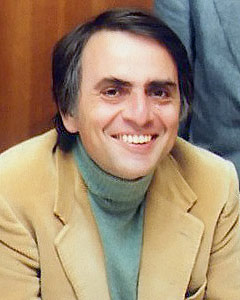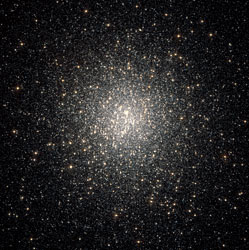
Carl Sagan
1934 - 1996
Astronomer and astrophysicist.
Pulitzer Prize winning author of Cosmos.
Winner of the Oersted Medal and many other awards including eighteen honorary degrees from American colleges and universities for his contributions to science, literature, education, and the preservation of the environment.

One of the leading astronomers of our time, Dr. Carl Edward Sagan, was born on November 9, 1934 in Brooklyn, New York. He received a bachelor's degree in 1955 and a master's degree in 1956 from the University of Chicago. Sagan taught at Harvard University in the early 1960s. He moved to Cornell in 1968 where he became a full professor in 1971. Sagan also played a leading role in NASA's Mariner, Viking, Voyager and Galileo expeditions to other planets. He has received NASA Medals for Exceptional Scientific Achievement and twice for Distinguished Public Service and the NASA Apollo Achievement Award.
Carl Sagan is perhaps best known for his work on the PBS series, Cosmos. This series won both an Emmy and a Peabody award and became the most watched series in public-television history. It was seen by more than 500 million people in 60 countries. The companion book to the series was on The New York Times bestseller list for 70 weeks and was the best-selling science book ever published in English.
Dr. Sagan was the David Duncan Professor of Astronomy and Space Sciences and Director of the Laboratory for Planetary Studies at Cornell University. He played a leading role in the Mariner, Viking, and Voyager spacecraft expeditions to the planets, for which he received the NASA Medals for Exceptional Scientific Achievement and for Distinguished Public Service. Dr. Sagan was also a research assistant of the Nobel Prize-winning geneticist H. J. Muller. His continuing research on the origin of life began in the 1950s. The Masursky Award from the American Astronomical Society states "his extraordinary contributions to the development of planetary science. As a scientist trained in both astronomy and biology, Dr. Sagan has made seminal contributions to the study of planetary atmospheres, planetary surfaces, the history of the Earth, and exobiology. Many of the most productive planetary scientists working today are his present and former students and associates."

Dr. Sagan was the David Duncan Professor of Astronomy and Space Sciences and Director of the Laboratory for Planetary Studies at Cornell University. He played a leading role in the Mariner, Viking, and Voyager spacecraft expeditions to the planets, for which he received the NASA Medals for Exceptional Scientific Achievement and for Distinguished Public Service. Dr. Sagan was also a research assistant of the Nobel Prize-winning geneticist H. J. Muller. His continuing research on the origin of life began in the 1950s. The Masursky Award from the American Astronomical Society states "his extraordinary contributions to the development of planetary science... As a scientist trained in both astronomy and biology, Dr. Sagan has made seminal contributions to the study of planetary atmospheres, planetary surfaces, the history of the Earth, and exobiology. Many of the most productive planetary scientists working today are his present and former students and associates."
Dr. Sagan has published more than 600 scientific papers and popular articles. He is the author and co-author or editor of more than 20 books, including The Dragons of Eden, for which he won the Pulitzer Prize in 1978. The U.S. paperbound edition of his book Pale Blue Dot: A Vision of the Human Future in Space appeared on best-seller lists worldwide. His reading of an abridged audiocassette version was nominated for a Grammy and was cited by Publisher's Weekly as one of the "two best audiobooks of the year." Sagan also published The Demon-Haunted World: Science as a Candle in the Dark, which became Sagan's eighth New York Times bestseller. With his wife, Ann Druyan, he co-produced a major motion picture from Warner Brothers based on his novel Contact.
Sagan was also the co-founder of The Planetary Society. This 100,000-member organization is the largest space-interest group in the world. The society supports major research programs such as the radio search for extraterrestrial intelligence, the investigation of near-Earth asteroids and, the development and testing of balloon and mobile robotic exploration of Mars. Sagan was a Distinguished Visiting Scientist at the Jet Propulsion Laboratory in California. He was also the contributing editor of Parade Magazine, where he published many articles about science and also about the disease that eventually claimed his life in 1996.




